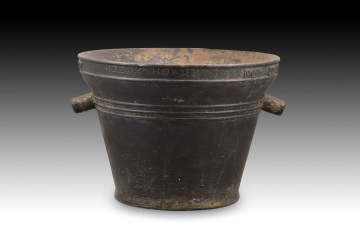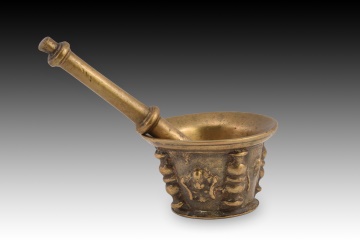Results 1 to 10 of 10
«« « 1 » »»
-
Special Offer! -10% Off

Inscribed mortar. Bronze. Spain, 1823. Bronze mortar with a flared mouth and a seamless, truncated cone-shaped body, tapering in diameter to the base. It features two handles or "pieces" toward the smooth decorative moldings on the top. The piece features, almost on the rim, an inscription (I AM FROM D. GREGORIO OCANA, YEAR 1823) in capital letters and a date in Roman numerals with spaces between them; and the text (reversed from the other) "Mazon fecci" (Mound of Fire); both flanked by a simple molding above and another below. This large mortar is of the type commonly known as "hospital" because it was commonly used for medicines in settings with many sick people or in important apothecaries. Typologically, it follows the usual pattern in these examples from the Spanish school during the 19th century: smooth, with moldings, and, as a rule, without the ribs (or derivatives thereof) that often appeared in the earlier ones. Compare, for example, with the large pharmacy mortar in the Municipal Museum-Archive of Calella (with an inscription, ribs, and human heads as handles), a large mortar and pestle in the Museum of Hispanic Pharmacy at the Complutense University of Madrid, etc.
· Size: 37x34,5x25 cms.
ANTIQUES
MISCELLANEUS;MORTARS
Ref.: ZF1007
-
Mortar with inscription. Bronze. Spain, 1846. Mortar made of bronze with a flared mouth and a truncated cone-shaped body that develops without discontinuity and decreases in diameter towards the base. The piece has an inscription (“soi de don Gregorio goia ano 1846”) in capital letters with spaces between them and two areas with lines flanking the text in the upper and lower areas, referring to the owner of the mortar and the year in which it was made. Compare, for example, with the large pharmacy mortar in the Municipal Museum-Archive of Calella (with an inscription, ribs and human heads as handles), a large mortar in the Museum of the Spanish Pharmacy of the Complutense University of Madrid, etc.
· Size: 25x25x30 cms.
ANTIQUES
MISCELLANEUS;MORTARS
Ref.: Z5727
-
Pharmacy mortar. Bronze. Spain, 1816. A mortar with a flared mouth, decorated with ribs derived from pillars and a band in the upper area with an inscription (I am Don Juan Antonio Martínez, apothecary in Nabalmoral de Pusa / Year 1816); the handles have been lost. Navalmoral de Pusa is a municipality in Toledo that was united in the 19th century with Navalmoral de Toledo, giving rise to Los Navalmorales. The decoration of the piece follows the usual for this type of mortar from prominent pharmacies. Weight: 39 kg.
· Size: 30,4 x 30,4 x 21 cm.
ANTIQUES
MISCELLANEUS;MORTARS
Ref.: ZF0792
-
Iron pharmacy mortar. 18th-19th centuries. An old cast iron mortar for pharmaceutical use. It follows the usual structure for this type of utensil between the 15th and 19th centuries, with a truncated cone-shaped body with very thick walls that has vertical ribs and perpendicular protruding handles to facilitate gripping during use. In this case it shows eight polylobed ribs and two large handles with ends in the shape of a child's head, indicating that it would be a piece from the Baroque period or later, probably from the 18th or 19th centuries.
· Size: 40x31,5x26 cms. Mano: L. 40 cms
ANTIQUES
MISCELLANEUS;MORTARS
Ref.: ZF1242
-
Flemish mortar. Bronze. 17th century. Presents brand. A mortar with a circular base and a mouth that extends outwards from the two upper bands and a body with a slight entasis and a relief decoration with figurative motifs. In addition to a series of mouldings on its outer area, two male protomes can be seen (heads with moustaches and non-human features) and a band with different elements on the lower part (scrolls, leaves, quadruped monsters). Also note a kind of circular “seal” (or so it seems), with letters (HLB / RA/TE) around a flag flanked by plant elements and placed on three oval objects. Compare this example with those by P. van den Ghein from the Royal Carillon School Museum “Jef Denyn” in Mechelen (although they are older), a 17th century example from the Pharmacy Museum in Berlin (Germany), another in the Pharmacy Museum of the Complutense University of Madrid (Spain), etc. Weight: 4.6 kg.
· Size: 17x17x14 cms.
ANTIQUES
MISCELLANEUS;MORTARS
Ref.: ZF1258
-
Mortar. Carved stone. 18th century. Mortar made from a single piece of carved stone with a circular base and four handles or worn projections carved towards the outside of its body, in the shape of a cup. This type of piece was created for use in apothecaries (which could be in a city, in a religious institution or in a hospital) or in a kitchen (of a large residence or, again, of a religious institution), and it is not possible to specify its purpose further due to the lack of decorative elements and the usualness of the model to which this piece belongs, with a long tradition in Europe. Similar examples are preserved, for example, in the Museum of the Spanish Pharmacy of the Complutense University of Madrid, the Museum of the History of Pharmacy in Seville, the Museum of Pharmacy in Krakow, etc.
· Size: 73x73x45 cms.
ANTIQUES
MISCELLANEUS;MORTARS
Ref.: Z1057
-
Mortar and pestle. Bronze. 15th century. Bronze mortar and pestle with a circular base and a spouted mouth decorated with a band beneath the rim. The base, facing outward, features three smooth lines in relief, above which appears a decoration framed by a band at the top consisting of heavily worn elements or masks over Gothic-style calligraphy. Reminiscent of French pieces held in private collections. Weight: 2.8 kg.
· Size: 13x13x9.5 cms
ANTIQUES
MISCELLANEUS;MORTARS
Ref.: ZF1401
-
Mortar and pestle. Bronze. 17th century. Mortar with a circular base, cylindrical body and mouth slightly flared outwards, decorated with a series of smooth horizontal mouldings arranged both at the bottom and at the top and with some simple vertical elements (which still maintain slight balustrade shapes) derived from the ribs that these specimens used to have in the medieval Spanish school.
· Size: 13x13x8,5 cms
ANTIQUES
MISCELLANEUS;MORTARS
Ref.: ZF0966
-
Mortar and pestle. Bronze. 19th century. Mortar with a flared mouth and relief decoration on the exterior based on balustraded elements (reminiscent of the ribs that these objects often had in the Spanish school during the Gothic period) alternating with floral motifs. The piece is hand-made, decorated with plain moldings of varying widths, as is customary. Weight: 3.5 kg.
· Size: 14x14x9,5 cms. L. 22,5 cms.
ANTIQUES
MISCELLANEUS;MORTARS
Ref.: ZF1405
-
Sold

Mortar and pestle. Bronze. Spanish school, 17th century. Bronze mortar with a flared mouth, a raised base towards the outside and a cylindrical body decorated on the outside with reliefs alternating shapes (probably figurative in origin, perhaps angel or Medusa heads) and balustrade shapes derived from the usual ribs, typical of this type of piece within the Spanish school since the Gothic period. The pestle, cylindrical in shape, has a decoration of smooth discs of different diameters and widths, arranged towards the centre and towards the end, and a flat widening at the beginning. Weight: 1.7 kg.
· Size: 11,5x11,5x7 cms.
ANTIQUES
MISCELLANEUS;MORTARS
Ref.: ZF1225